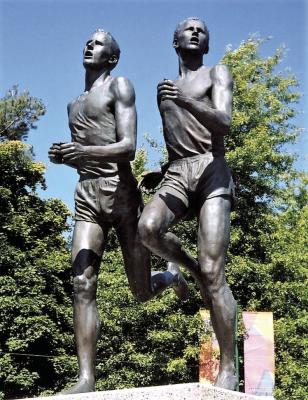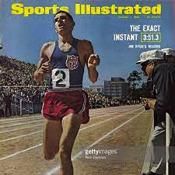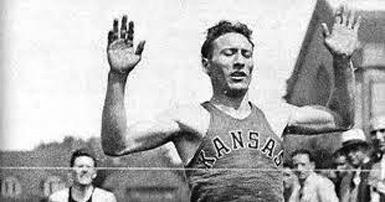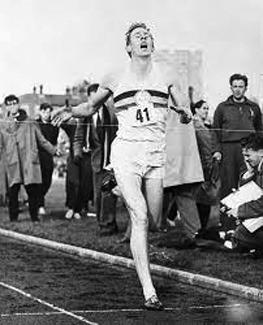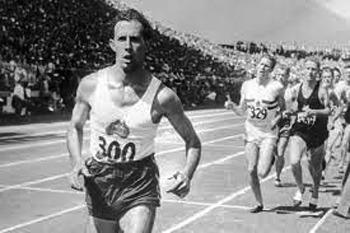Four-minute mile no longer elusive
One thing I like about Facebook is that it reminds me about the birthdays of my friends. I have an easy opportunity to wish them a Happy Birthday, something I would probably not do without the reminder. My wife is much more intentional and sends out birthday cards via the U. S. Postal Service on a regular basis. I am often reminded on FB about important anniversaries, which again offers me a chance to send greetings.
One anniversary that quietly went past me wasn’t anyone’s 50th (or more) wedding anniversary, but was an important day in the World of Sports that took place 69 years ago. May 6, 1954 was the date that Roger Bannister of Great Britain broke the four-minute barrier in running the mile. Bannister ran the mile in 3:59.4, to become the first human to run a subfour- minute mile.
I remember hearing about it on the radio as I was listening to one of my favorite evening programs. I had a ritual of coming home from school, eating a snack my Mother had prepared and settling in to listen to Bobby Benson and the B-Bar-B Riders, or Wild Bill Hickock or Sgt. Preston of the Yukon or Sky King or some such programs. Between shows, the local announcer came on with the news that Bannister had achieved the feat the day before.
I remember being disappointed. I was a fan of the American runner Wes Santee, who had flirted with the 4:00 minute mile. I was hoping Santee would be the first to break the barrier. Barrier is a good word to use in terms of running the mile. Athletes had come relatively close to four minutes for a long time, but never could quite get over the hump. There were those, including some scientists, who opined that the human body may be incapable of running that distance in less than four minutes.
But Bannister did achieve the mark and earned his place in History, let alone Sports History. Once the barrier was broken, others joined him in rapid succession. His record lasted only 46 days as Australian runner John Landy ran a 3:58.0-minute mile in a race in Finland.
Bannister was a unique individual. He was a medical student when he ran the first sub 4-minute mile. He later would become a renowned neurologist.
According to accounts at the time, the record-breaking race was set up with two pacers. The first pacer was Chris Brasher, and Bannister and Brasher immediately went to the front of the pack. Brasher finished the first 440 yards at :58 and at the halfmile spot at 1:58. Bannister was a step behind. Chataway was just a stride behind Bannister at this point, but then he took over and led at the three-quarter point with a time of 3:01. Bannister began his finishing kick with about 275 yards remaining in the race and passed Chataway to finish first. He had run the last lap in :59.
The track announcer teased the crowd with a longwinded spiel about the race, finishing by announcing the time. When he uttered the words “three minutes” the crowd broke out in a huge roar. No one heard him add “59.4 seconds”.
Landy, like Santee, was a runner who had flirted with the 4:00 mark for a few years. For some reason, I liked Landy even less than I did Bannister and when the two met in a race in August in Vancouver, I was rooting for Bannister. Before the race took place, Landy was by far the overwhelming favorite to win. I remember hearing announcers saying that Landy was a pure runner, and Bannister was somewhat of a novice. Landy had the right kind of training techniques and would likely dominate the race. When the two started running in the showdown race, it appeared the conventional wisdom was on target as Landy quickly built a lead, which got as long as 10 yards, according to reports. Bannister started a strong kick at the end and pulled even with Landy, who looked over his left shoulder to gauge his lead. Bannister passed him on his right and won the race with a time of 3:58.8. Landy’s time was 3:59.6. Later both Landy and Bannister agreed that the turning point in the race’s outcome was when Landy took that ill-advised glance over his shoulder. A statue in Vancouver at the site of the Empire Stadium was created, which showed the two runners side-by-side with Landy looking back over his shoulder.
Those were the first two to break the barrier. There have been 1,664 runners to run the distance in less than four minutes in the 69 years since. Not long before his death in 2018, Bannister was asked if his accomplishments on the track were the ones of which he was most proud. His response was that while he was proud of what he had done in running, he was most proud of the accomplishments he achieved in the field of medicine.
Growing up in Kansas, I was proud of my state’s connection with great mile runners. As a youth, I heard runner Glenn Cunningham give an athletic banquet speech. Cunningham was a wellknown inspirational speaker, who had an inspirational story to tell. At eight years old he was severely burned in an accident that claimed the life of his older brother. The doctors recommended amputating young Glenn’s legs, but his parents would not allow it. Doctors told the parents that Glenn wouldn’t walk normally again because he had lost all the flesh on his knees and shins and all the toes on his left foot as well as his transverse arch practically destroyed. It took two years for him to try to walk again, but therapists had been working with him in an experimental type of therapy which apparently worked pretty well. When Cunningham spoke at the banquet, I remember him saying that a positive attitude on a strong religious faith was what got him through the ordeal. He quoted his favorite Bible verse, which I remember because it was a favorite of my Mother’s-- Isaiah 40:31: “But those who wait on the Lord shall renew their strength, they shall mount up with wings like eagles, they shall run and not be weary, they shall walk and not faint.”
Anyway, Cunningham began running and he eventually became one of the world’s top middle-distance runner, competing in the halfmile and mile. He ran in the 1932 and 1936 Olympics competing in the 1500-meter run. In 1934, he held the world record for the mile at 4:06.8. He ran a 4:04 on an indoor track at Dartmouth College, but the time was disallowed because he had pacers, which were not permitted at the time.
Later in life, he and his wife had a ranch in Kansas, on which they took in homeless and abused children. A lot of youngsters benefited from this ministry.
I mentioned Wes Santee, another Kansan, as being the one I rooted for to break the 4:00-minute barrier. Santee was around the mark often, but never could quite get over the hump. His best opportunity may have been in a 1954 race with Olympic champion Josy Barthel. Santee set a 1500-meter record in the race by running that distance in 3:42.8, but since the event was a mile race, it went on. Santee slowed a little after passing Barthel and finished the mile at 4:00.8. Later he ran his best ever time at 4:00.6. He was suspended a little later because he accepted expense money and was disqualified by the AAU as an amateur.
Yet another Kansas, Jim Ryun, made his mark as being the first high school miler to break four minutes, while a junior at Wichita East High School. I saw him run in the Kansas State Track meet which was held in Manhattan and he won by breaking four minutes. Ryun went to the Olympics as a high schooler in 1964 and then again in the Olympics of 1968 and in 1972. The 1968 event was held in Mexico City and the altitude hurt Ryan as Kenyan runner Kipchoge Keino, who was used to running in high altitudes, won the race with Ryun earning silver. In the 1972 Olympics, Ryun was tripped early in the race and lost that one as well. He never won a gold medal, even though he was considered the world’s top miler.
Anniversaries are special. Reliving the anniversary of Bannister’s accomplishment has been special as well.

